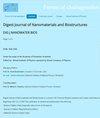比较共沉淀法和溶胶-凝胶法对ZnO和Zn(1-x)Fe0.05CoxO纳米颗粒室温铁磁性(RTFM)结构和磁性的影响
IF 1
4区 材料科学
Q4 MATERIALS SCIENCE, MULTIDISCIPLINARY
Digest Journal of Nanomaterials and Biostructures
Pub Date : 2023-09-20
DOI:10.15251/djnb.2023.183.1025
引用次数: 0
摘要
本研究采用溶胶凝胶法和共沉淀法制备了ZnO和Fe/Co共掺杂ZnO纳米粒子(Zn1-x Fe0.05 Cox O, x = 0,0.005)。用x射线衍射技术测定了纳米颗粒的结构性质,证实了纳米颗粒的六方纤锌矿结构。共沉淀法合成的样品晶粒尺寸为18.68 ~ 37.43 nm,溶胶-凝胶法合成的样品晶粒尺寸为19.97 ~ 38.45 nm。利用傅里叶变换红外透射光谱研究了所制备的纳米颗粒中官能团的类型。利用紫外-可见吸收光谱研究了ZnO的光学性质和Fe/Co在ZnO半导体基体中的掺杂。随着掺杂剂浓度的增加,共沉淀法合成的样品带隙在3.03 ~ 3.68 eV之间,溶胶-凝胶法合成的样品带隙在3.13 ~ 3.86 eV之间。用振动样品磁强计对合成的纳米粒子的磁性行为进行了研究,结果表明两种方法制备的掺杂纳米粒子具有弱铁磁性。与溶胶-凝胶法制备的样品相比,共沉淀法制备的样品具有更高的饱和磁化强度和矫顽力。在两种合成方法的比较中,观察到颗粒尺寸,能带隙和磁化值略有变化。在自旋电子学领域的实际应用中,光学和磁性行为的改善有利于共沉淀法而不是溶胶-凝胶法获得室温铁磁性。本文章由计算机程序翻译,如有差异,请以英文原文为准。
Comparison the effect of co-precipitation and sol-gel techniques on the structural and magnetic attributes of ZnO and Zn(1-x)Fe0.05CoxO nanoparticles for attaining room temperature ferromagnetism (RTFM)
In current study, ZnO and Fe/Co co-doped ZnO (Zn1-x Fe0.05 Cox O where x = 0, 0.005) nanoparticles were prepared by using two different methodologies: sol gel method and coprecipitation method. The structural properties were determined by X-Ray diffraction technique which verifies the hexagonal wurtzite structure of prepared nanoparticles. Crystallite size varies from 18.68-37.43 nm for the samples synthesized by co-precipitation method and it varies from 19.97-38.45 nm for sol-gel method. Fourier transform infrared transmittance spectra were used to investigate the type of functional groups present in all the prepared nanoparticles. The UV-Visible absorption spectroscopy was employed to investigate the optical properties of ZnO and doping of Fe/Co in ZnO semiconducting host. The energy band gap varies from 3.03 - 3.68 eV for the samples synthesized by coprecipitation method and for sol-gel method, it ranges from 3.13 - 3.86 eV, by increasing dopant concentration. Vibrating sample magnetometer was used to inquire the magnetic behavior of synthesized nanoparticles which shows the weak ferromagnetic behavior of the doped nanoparticles prepared by both the techniques. Samples prepared by co-precipitation method showed higher values of saturation magnetization and coercivity as compared to the samples prepared by the sol-gel method. In comparison of two synthesis techniques, a slight change was observed in the particle size, energy band gap and magnetization values. The improved optical and magnetic behavior favors the co-precipitation method rather than sol gel method for obtaining room temperature ferromagnetism for practical applications in spintronics field.
求助全文
通过发布文献求助,成功后即可免费获取论文全文。
去求助
来源期刊

Digest Journal of Nanomaterials and Biostructures
工程技术-材料科学:综合
CiteScore
1.50
自引率
22.20%
发文量
116
审稿时长
4.3 months
期刊介绍:
Under the aegis of the Academy of Romanian Scientists
Edited by: -Virtual Institute of Physics operated by Virtual Company of Physics.
 求助内容:
求助内容: 应助结果提醒方式:
应助结果提醒方式:


